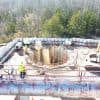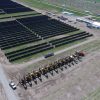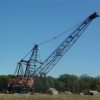PROJECT DETAILS
Omaha Nebraska is the largest city in Nebraska with a population of over 400,000 people. A growing city the size of Omaha needs crushed stone and gravel to build the roads, sidewalks and foundations on which the people depend. Weeping Water, NE is a small town just 20 miles southwest of Omaha that supplies most of the rock for the Omaha market. Limestone mining operations have been in existence for nearly 100 years in this small town.
A normal limestone operation is usually done in an open pit after the overburden has been taken off, but not in Southeast Nebraska. In this part of the country there is over 100’ of corn growing dirt on top of the limestone. To add to the problem there is another 110’ of non usable rock on top of the Kereford/Platsmouth formation which is the target material for the limestone operation. Due to the massive amounts of overburden and junk rock economics dictate that in order to extract the good limestone it must be removed using underground mining techniques. This underground mining operation uses a room and pillar drill and blast method to extract the rock. Years of mining have left a labyrinth of rooms that spread out from the one and only entrance into the mine. Miles of roads have to be traversed by haul trucks laden with the broken rock to reach the outside world.
Engineers were called in to design a way to get to a 20 1/2-foot layer of high quality Kereford/Plattsmouth limestone that is over 200-feet deep. It was decided that the most economical way to reach this layer of rock would be to ramp down to it and remove all the material out of the way. As a safety feature the engineers would put in catch benches. These specially designed benches would keep material from falling from the top all the way to the bottom. By taking a giant triangle out of the ground, haul trucks would be able to drive down the ramp and straight into the Kereford/Plattsmouth limestone layer.







